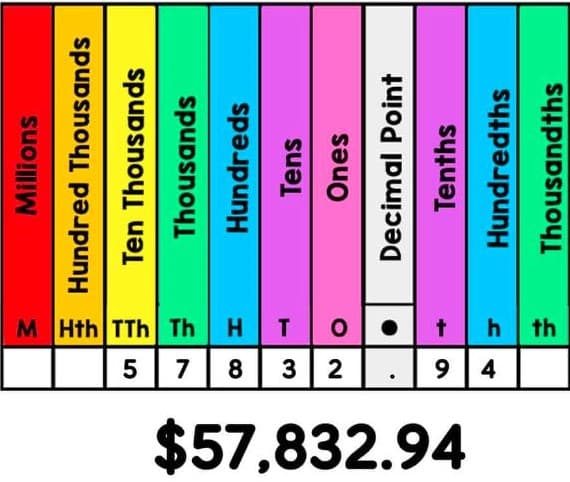
Place value is one of the most fundamental concepts in mathematics, serving as the cornerstone for understanding larger numbers, performing arithmetic operations, and developing number sense. Despite its simplicity, place value is a profound idea that supports a wide range of mathematical learning and application.
What is place value?
Place value refers to the value of a digit depending on its position within a number.
In the base-10 (decimal) system, which is the standard system for denoting integer and non-integer numbers, each position represents a power of 10. For example, in the number 832, the digit 2 is in the “ones” place, the digit 3 is in the “tens” place, and the digit 8 is in the “hundreds” place. This means:
- 2 represents 2 ones or 2
- 3 represents 3 tens or 30
- 8 represents 8 hundreds or 800
In the grid below is a place value grid to present the Millions, Hundred Thousands, Ten Thousands, Thousands, Hundreds, Tens, Ones, tenths, hundredths, and thousandths.

Historical development of place value
The concept of place value has evolved over centuries. Ancient civilizations like the Babylonians used a base-60 system, while the Mayans employed a base-20 system. The development of the base-10 system is credited to ancient Indian mathematicians, whose work was later transmitted to the Islamic world and then to Europe. The introduction of zero as a placeholder was a revolutionary idea that significantly enhanced the utility of the place value system.
Importance of place value
- Foundation for arithmetic: Understanding place value is crucial for performing arithmetic operations such as addition, subtraction, multiplication, and division. It helps to align numbers correctly and simplify calculations.
. - Number sense: A firm grasp of place value contributes to a better understanding of the magnitude of numbers, allowing students to make reasonable estimates and understand the relative size of numbers.
. - Mathematical operations: Place value knowledge is essential for advanced mathematical concepts, including algebra, where numbers and their positions play a critical role in solving equations.
Common misconceptions
- Confusing digits and values: Students often confuse the digit with its value. For example, in the number 506, they might think the 5 is just a 5, not 500.
. - Ignoring placeholders: Some students ignore zeros as placeholders, leading to errors in understanding and calculations.
. - Misunderstanding regrouping: During addition or subtraction, students might struggle with the concept of carrying over or borrowing due to a weak understanding of place value.
Practical applications
- Financial literacy: Place value is essential in understanding money, budgeting, and financial calculations.
. - Data interpretation: Interpreting large numbers in statistics, science, and technology relies on a solid grasp of place value.
Conclusion
Place value is more than just a mathematical concept; it is a foundational skill that supports a wide range of mathematical and real-world applications. By building a solid understanding of place value, students can develop better number sense, perform arithmetic operations with confidence, and apply their knowledge in various fields. Effective teaching strategies and a focus on common misconceptions can help students master this essential concept, paving the way for their future success in mathematics and beyond.
Worksheets with answers
- 1st Grade place value worksheet (ones, tens)
- 2nd Grade place value worksheet (ones, tens, hundreds)
- 3rd Grade place value worksheet (ones, tens, hundreds, thousands)
- 4th Grade place value worksheet (ones, tens, hundreds, thousands, ten thousands)
- 5th Grade place value worksheet (thousands, ten thousands, hundred thousands)
- 6th Grade place value worksheet (thousands, ten thousands, hundred thousands, millions)
- 7th Grade place value worksheet (thousands, ten thousands, … millions, ten millions)
Edublox offers cognitive training and live online tutoring to students with dyslexia, dysgraphia, dyscalculia, and other learning disabilities. Our students are in the United States, Canada, Australia, and elsewhere. Book a free consultation to discuss your child’s learning needs.
Authored by Shanice Jordaan. Shanice holds a bachelor’s degree in education and has extensive teaching experience, having taught math for five years and English for three. She leverages her skills as an English teacher, online ESL teacher, and math and reading tutor to design engaging lessons, foster positive learning environments, and cater to diverse learning needs. Worksheets created by Caitlin Jacobs.
